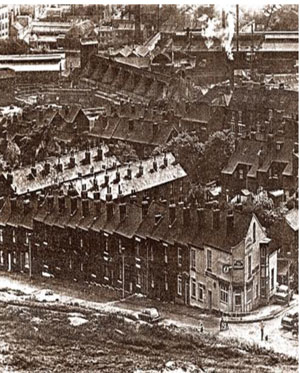‘Carts came round selling milk, fish and all sorts – even pikelets and oatcakes. The milk man was a farmer who brought milk in churns with a horse and cart. Once the cart came loose and ran off down the street it was so steep’ – Vera
Lots of people have brought us their memories of Parkwood Springs – playing there as children, wartime memories of army billets and anti aircraft guns, the ammunition dump, the brickworks and the power station – we would love to hear more.
Some of the most vivid recollections are those from people living in Parkwood Springs village which is still marked on maps as Douglas Road, Vale Road, Pickering Road and Wallace Road, just below the ski village. Built in the 1860s alongside the railway line, the terraces of back to backs and houses with small back yards, five shops, two pubs, a chapel and a windswept playground formed an ‘island village flanked by the Manchester railway, quarries, earthworks and a vast tipping area. On all sides the land rises so steeply that the only entry by road is through steelworks under a low, narrow railway bridge’ (Sheffield Star 1970). Villagers mainly worked on the railways and in the steelworks, but people at Parkwood felt cut off from the rest of Sheffield, ‘Even people in Shirecliffe didn’t know where Parkwood Springs was.’
The village’s isolation created a close-knit community where everyone was friendly, looked out for each other and felt a strong bond of belonging. But the isolation was to become the village’s biggest problem as during the 1960s and 70s Victorian terraces in Sheffield gave way to high rise developments and ‘modern’ living. Houses fell into disrepair and people began tomove away, leaving Parkwood Springs a ‘forgotten village’ with no plans for redevelopment or renewal.
The first bus service was provided only in 1971 to help older residents in and out of the village.
The Star reported in 1970: ‘As I walked up Pickering Road to the playground, I could understand why relatives rarely visit – it is simply too steep and inaccessible.’
Christine said: ‘ You had to push cars up the hill in the snow – we got 6d when we got them to the top.’ Ray said: ‘At the bottom of the hill to get to school you had to go down 100 steps, a cobbled gennal and through a dark tunnel.’
Julie said:’ It wasn’t nice to go out on dark nights because of coming back. My dad used to wait for me at the 53 bus stop to walk back up the hill. You daren’t be late home. We didn’t have mobile phones then.’ Ray said: ‘ In winter we used to sledge down the streets and the clay heap by the brickyard. We collected clay and made hollow boxes that we baked in the kitchen range. The steel workers at the Hallamshire steelworks gave us ‘oily wop’ (fabric soaked in oil) to burn in our ‘winter warmers’ to keep our hands warm.’
Residents attempted to revitalise the village and there were no plans for redevelopment, nevertheless demolition was complete by 1974. There are still no plans for that small, steep area below the ski village, although it is designated a business development site. However, it may be possible for the City Council to generate income from development there which could be used to maintain and improve the rest of Parkwood Springs for the future.
We have many more memories of Parkwood Springs – the village and the country park – please bring us yours. Words, photos and drawings welcome.

